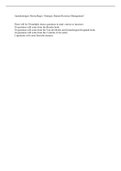Aantekeningen Hoorcolleges ‘Strategic Human Resource Management’
There will be 50 multiple choice questions in total: correct or incorrect
28 questions will come from the Boselie book.
10 questions will come from the Van der Molen and Gramsbergen-Hoogland book.
10 questions will come from the 5 articles (2 for each).
2 questions will come from the lectures.
,Hoorcollege 1 (Chapter 1)
Introduction: SHRM in the 21st century
Focus on SHRM leadership
Ambitions are strong predictors for career success. Believe in your own success only can
when you have ambitions.
HRM= potential source for achieving organizational goals
HR practices (education, teambuilding, selection, socialization, talent management)
employee outcomes (happy, wellbeing, turnover, intention to turnover) organization
outcome (revenues etc.)
Employees turnover= leaving company, employee absence.
Employability= labor market attractiveness, career potential
“…employees matter and the management of employees (human resource management) is a
potential source for achieving organizational goals.”
Social network, money, part of a family, meaningful SHRM for employees
Strategic Human Resource Management in the 21st Century:
• Impact of organizational change
• Competitiveness
• Three perspectives (MHRM, IHRM & SHRM)
• Stakeholder perspective
• Balanced approach
Multiple stakeholder perspective= perspectives, feelings of individual employees, labor
maket, supervisors, society as a whole, etc. (different work perspectives, for example age for
retirement). Long term perspective and short-term perspective.
Balanced approach= we try to balance employee at work and employee at home. You are
not only looking into HRM short-term perspective but also in long-term perspective. Protect
your employee.
Impact of organizational change:
Five I’s (Schabel)
1. Internationalization (increase)
2. Individualization (increase)
o People want to fulfill their infinities in their work and private life
3. Informalization
o Organizations are becoming flatter (management functions are changing)
o Power distance
4. Informatization (technological changes, ICT, labour markets)
5. Intensification (individuals are more network oriented, reach their career goals,
spending more time on family and friends)
,Organization change:
• Acquisitions
• Mergers
• Reorganizations
• Strategic alliances
• Private equity interventions
• Global crisis
• Financial crisis
• Ageing population
• Etc.
Deze bovenstaande punten hebben impact op organisaties en impact op medewerkers.
Organizational Change and Competitive Advantage
The relevance of optimal coping with change is embedded in the concept of competitive
advantage.
Competitive advantage:
• Is important for organizational survival;
• And is at least partly manageable by human resource management.
Three HRM perspectives:
1. Micro HRM – MHRM
2. International HRM – IHRM
3. Strategic HRM – SHRM
Micro HRM:
MHRM= Micro HRM, Organizational behavior, protecting the wellbeing of people,
combine psychological insights, organizational behavior, obey literature together with HRM.
Focused on the individual employee development.
Micro HRM (MHRM) covers the sub functions of HR policy and practice including
recruitment & selection, induction & socialization, and training & development.
MHRM is closely related to the studies in Organizational Behaviour and Occupational
Psychology often focused on the impact of single HR practices on employee attitudes and
behaviours (Wright & Boswell, 2002).
Instroom, uitstroom en doorstroom (recruitment, selective, socialize, culture, norms and
values, promotion, training and development, turnover, outplacement, intention to leave)
International HRM
IHRM= International HRM, multinational companies, expatriate (iemand die voor zijn
werk tijdelijk in het buitenland woont)
International HRM (IHRM) is concerned with HRM in multinational companies (MNCs)
and HRM across borders (Brewster, 2004). IHRM is focused on issues such as the
transferability of HR practices across business units in different countries, the optimal
management of expatriates and the impact of different institutional country contexts on
human resource management.
, Strategic HRM
SHRM= Strategic HRM, micro focus with strategy and the organizational level and
perspective.
Strategic Human Resource Management (SHRM) focuses on issues of linking HRM to the
business strategy, designing high performance work systems and adding value through good
people management in an attempt to gain sustained competitive advantage (Delery & Doty,
1996). The concept of ‘fit’ plays a central role within SHRM.
Three perspectives in studying SHRM practices
1. A multi-actor perspective (multiple stakeholders including employees, managers,
HR professionals, works councils, trade unions, top management, shareholders,
financiers and government);
2. A broad societal view with an emphasis on different institutional contexts, for
example, on the level of branches of industry, regions and countries;
3. A multi-level perspective including the individual employee perspective and the
strategic organizational perspective, teams
Paauwe (2004)
• Human resources are something more than just ‘resources’;
• Human resource management is not concerned solely with financial
performance;
• Human resource management focuses on the exchange relationship (psychological
contract) between employee and organization;
• And the shaping of the employment relationship takes place in an era of continuous
tension between the added value and moral values.
Boxall & Purcell (2008)
• HRM covers all workforce groups, including core employees (permanent contracts),
peripheral employees (temporary workers) and contingent workers;
• HRM involves line and specialist managers, and is not solely aimed at employees;
• HRM is all about managing work and people, collectively and individually;
• HRM is embedded in industries and societies
MD- programs= Management development programs
The balanced approach
In the strategic balance model, organizational success can only be achieved when financial
performance AND societal performance of an organization are above average in the particular
population in which the organization is operating (Deephouse, 1999).
The balancd approach in HRM
• Goals of the individual employee
• Organizational goals
• Societal goals
3 factors lead to better performance & personal satisfaction (movie)
1. Autonomy: the desire to be self-directed
2. Mastery: the urge to get better at stuff





